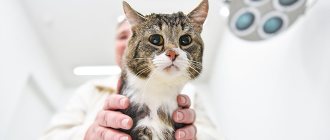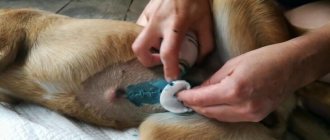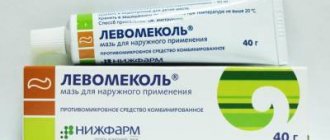Preparing for the cat sterilization procedure
To ensure that the operation does not harm the animal and is carried out as safely as possible, a number of measures should be taken in advance. There is an established procedure for preparing a cat for sterilization. The animal must undergo a series of procedures.
Special care will also be required. Compliance with all recommendations will help minimize the risks associated with surgical intervention in the body. It is necessary to donate blood and urine for analysis. In addition, you will need to examine the smear for microflora. It is recommended to check the heart and examine the abdominal cavity using ultrasound.
Surgery is performed only on healthy animals, so you need to pre-treat the cat if it is sick. In addition, you should choose the age for sterilization. Although the operation is performed on six-month-old animals, many experts advise waiting: if the kitten is operated on too early, the hormonal levels will be disrupted, which may lead to delayed physiological development.
Veterinarians recommend against performing surgery during estrus. Although there is no consensus on the admissibility of the procedure during this period, it is better to wait a week. Healing during this period may take longer.
It is not recommended to sterilize pregnant cats. The operation can be performed if there is a threat to the mother's life. Otherwise, veterinarians advise waiting, since the body undergoes a number of changes during the gestation period, due to which recovery may be more difficult.
Benefits of sterilization at home
In recent years, sterilization surgery has increasingly been performed at home for a number of reasons:
- In large cities it is quite difficult to get to the clinic without having to stand in traffic jams. A long road has a depressing effect on a cat, and unfamiliar sounds and smells of public transport can frighten or anger the animal.
- The time spent waiting in line for surgery is reduced.
- The risk of infections is reduced. Since cats have no contact with sick animals at home, four-legged patients with various airborne diseases are often brought to veterinary clinics.
At home, you will be close to your pet and help her survive this difficult period in comfortable conditions.
Many owners carried out the castration procedure at home, which helped them avoid many consequences. Often, home surgery is resorted to in cases where the animal is not vaccinated or there is no reliable data on vaccinations performed. It is not necessary to carry out surgical intervention in the clinic in such situations.
Worming
Owners often wonder whether their pet needs to be dewormed and when is the best time to do it.
The need for anthelmintic therapy depends on how long ago the pet was last treated. If the procedure was carried out no more than a month ago, you should not subject the animal’s body to additional stress. If the deworming remedy was last used a long time ago, the pet should be treated 10 days before the operation.
This measure is mandatory; animals infected with helminths are not allowed to undergo surgery.
To get rid of parasites, you can use various means. It is recommended to consult a veterinarian, who will tell you which medication is best suited in a particular case. Milbemax and Canikquantel are often used.
There are anthelmintic drugs that are applied to the animal's fur. They are considered safer for health, but their cost is much higher.
What should you not do the day before? Basic Rules
Preparing the cat for surgery begins 24 hours in advance. The veterinarian will tell you in detail what and how to do at this time. The main recommendations of doctors will be:
- Trim the claws to prevent the cat from injuring itself after surgery.
- Adhere to a proper diet.
- Avoid stress.
Is it possible to feed? In no case!
We stop feeding at least 12 hours before surgery. This is necessary so that the animal does not vomit while under anesthesia and when emerging from it.
What about drinking water?
Drinking water is not allowed 5 hours before surgery. It is imperative to ensure that the cat does not have access to water during this time.
Vaccinations
Since there is a risk of infection during surgery, it is recommended that all cats receive vaccinations before sterilization. You should think about this action in advance so that after vaccination the body has time to fully recover. The last vaccine must be administered at least 30 days before surgery.
Some owners do not want to vaccinate, believing that such an action will negatively affect the cat's health. In this case, you can also sterilize. The veterinarian will administer a special medication to your cat before surgery. This will strengthen the immune system, reduce the likelihood of infection, and avoid infections. The cost of such a procedure will be much higher.
How to prepare for surgery?
Surgery on a cat at home requires the same preparation as performing an intervention in a clinical setting. Before it is necessary to undergo a thorough examination of the animal's health status. Many clinics schedule the day of surgery without first undergoing tests and other examinations. You should not trust a simple examination, but rather insist on a full examination of your pet’s health condition. You may have to pay for it, but it is an investment in your pet's health. We recommend conducting the following research:
- blood and urine composition;
- Ultrasound of internal organs
- ECG.
These examination methods will help you make sure your cat is in good health, which will reduce the risk of surgery.
Quiet! The operation is underway!
A good veterinarian will not undertake to operate at home on a cat that has health problems. Although many clinics neglect this rule and cannot provide a full package of diagnostic services.
Nutrition before sterilization
Before surgery, you should not feed your cat for 12 hours. There will be no negative consequences from lack of food: cats easily tolerate hunger for 2 days. This measure is necessary to prevent a gag reflex during the operation: the cat may choke on vomit, which can cause unpleasant complications. A pet can also vomit during transportation: this situation often causes excitement and stress.
To get rid of feces, you can give your pet a little Vaseline oil. It has a laxative effect on the cat's body. In addition, you can use special laxatives. It is recommended to first select a suitable method and dosage with a specialist.
What is sterilization and how safe is it?
There is a wide variety of sterilization methods. They all boil down to the fact that the reproductive organs are removed during surgery. This leads to a general decrease in the animal’s hormonal levels and the cessation of its reproductive function.
The level of veterinary medicine is now quite high. If you contact a certified institution with good reviews, staffed by professionals, then the operation and post-operative care will be as safe as possible for your cat.
What additional things should you take with you?
You should take the pet's and owner's passports with you. To protect the seam from the cat’s attempts to lick it, you will need a special blanket, which will also become an obstacle to the penetration of pathogens of infectious diseases into the body weakened by the intervention. It is recommended to purchase several packages of dry and wet wipes in advance.
To avoid any difficulties, make the necessary purchases before sterilizing your cat. It is worth consulting a veterinarian.
Postoperative care
Constant attention for two days (during this time the cat will fully recover from anesthesia).
Important!
If your pet has a very difficult time with the post-operative period, does not recover from anesthesia for a long time, or has foam at the mouth, then you should definitely consult a doctor!
After the clinic, the cat needs to be laid on the floor (so that it does not fall from a height) on something soft, with a diaper laid on top and covered from above.
The animal should be placed on the right side so as not to create additional stress on the heart. If a sleeping cat's eyes are open, then they need to be closed approximately twice an hour so that the cornea does not dry out.
If vomiting begins, you need to turn the muzzle on its side so that the animal does not choke.
After 3-4 hours you can offer the animal water, and after 12 - food.
It is recommended to remove the litter from the tray for several days to prevent it from getting into the wound. Otherwise, you need to completely follow the doctor’s recommendations; you may have to treat the suture site, give the animal any medications, or even give injections.
Transporting a cat
The animal should be transported in a special carrier. You should not carry your pet in your arms.
A towel or thick blanket should be placed inside the transport device to avoid possible injury to the animal recovering from anesthesia. There is a possibility of uncontrolled urination. To prevent an unpleasant surprise, you can lay a diaper on the bottom.
The cat should be transported in a spacious carrier. Do not roll it into a ball as the seams may come apart. If the available means of transportation is not large enough, it is better to take a sports bag or basket for this purpose, the size of which will allow the pet to stretch out.
If the cat is being operated on in the winter, it will be necessary to wrap it in a blanket or blanket after sterilization to prevent hypothermia. The temperature of the animal recovering from anesthesia is reduced.
Some people don't want to take their cat to the hospital. They can call a veterinarian to sterilize the cat at home. The disadvantage of this solution will be the increase in the cost of the procedure.
Which surgical method is best to choose?
Almost any sterilization of cats is possible at home. The surgical technique depends on the wishes of the owner and the recommendations of the veterinarian. If you wish, you can do the following at home:
- classic “white line” intervention;
- surgery through a lateral incision;
- laparoscopy.
In most cases, veterinarians recommend laparoscopic sterilization of cats. This operation has many advantages: no long recovery period, minimal complications and ease of caring for the animal. During laparoscopy, fistulas or adhesions almost never form.
Laparoscopy is performed through small holes of 5 to 10 millimeters. After the operation is completed, they are tightened with a self-absorbing thread or filled with glue. During this operation, wearing a special blanket is not necessary, but some doctors recommend wearing it for a day. The advantage of laparoscopic sterilization is the short recovery period. In most cases, by evening the cat leads an almost normal lifestyle. This is greatly facilitated by the fact that the surgeon does not manipulate with his hands inside the incision. All stages of removal of reproductive organs are carried out using a sterile instrument.
Any operation is divided into several main stages:
- preparation for anesthesia;
- administration of anesthetics;
- direct surgical intervention;
- recovery from the state of anesthesia.
The recovery period ends everything. During this procedure, special attention should be paid to the following points: the condition of the sutures and vomiting. It is necessary to urgently take the animal to the veterinary clinic in cases where the cat is very nauseous or if the stitches are noticeably moist. With laparoscopy, the latter happens extremely rarely.
Dubious pity and true humanism
It is worth noting that cats “walk” 2-4, sometimes 6 times a year. This depends on the individual characteristics of the animal’s body. It has been scientifically proven that “empty” sprees without subsequent fertilization not only exhaust animals and their owners mentally, but also provoke the development of diseases of the reproductive organs in cats.
Letting her out every time to look for a partner under the pretext of dubious pity means dooming the pet to a short and far from happy life. Also, don’t forget about the offspring: the kittens will have to be placed somewhere.
True love and care for a cat is manifested differently: by sterilizing and not torturing her and yourself. Today, there are several methods for sterilizing cats. You will find out which one is better from this article.











